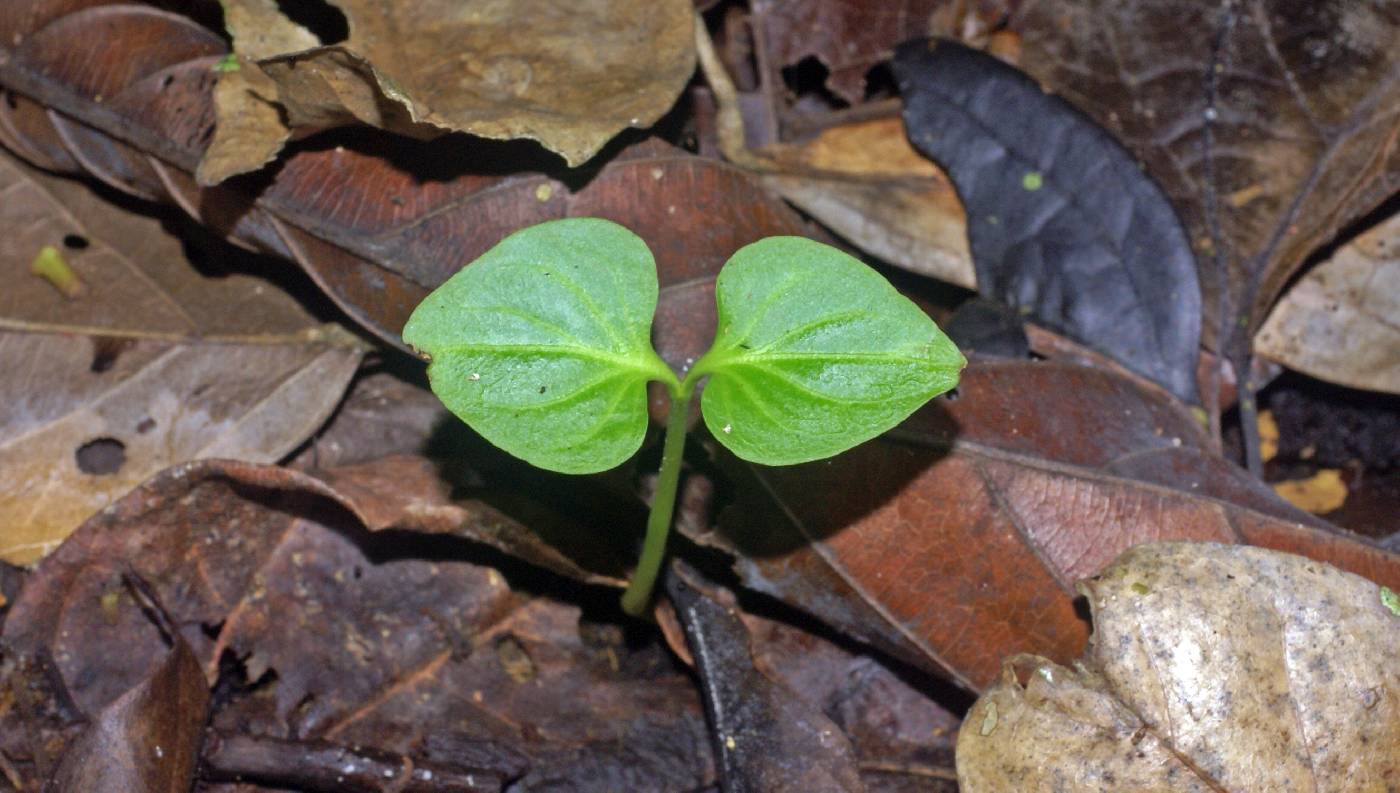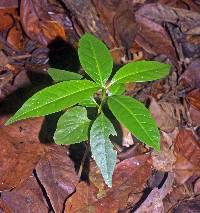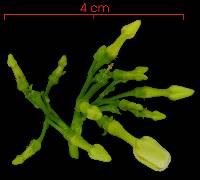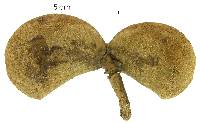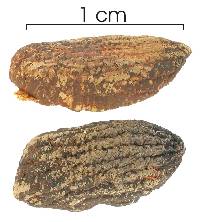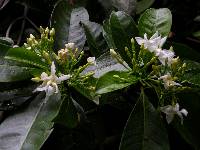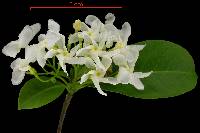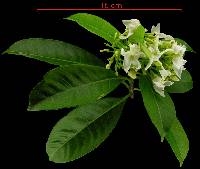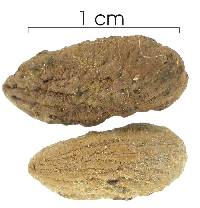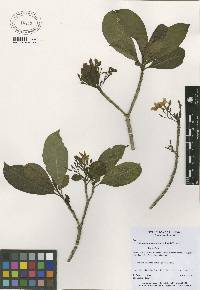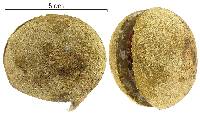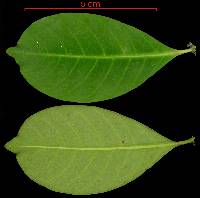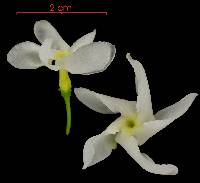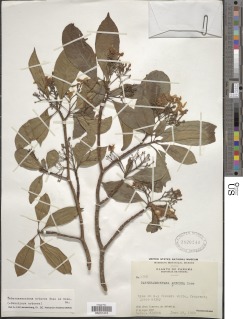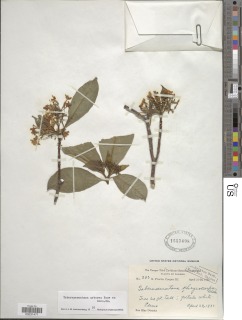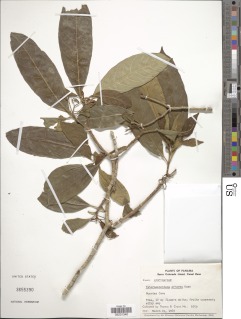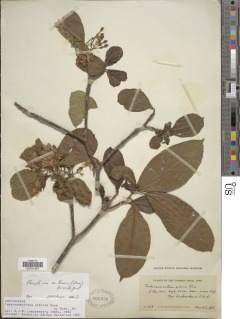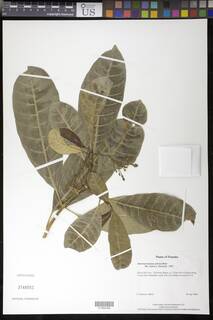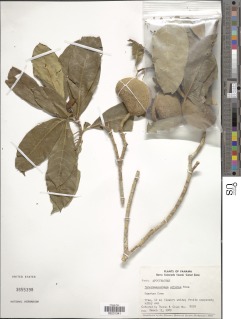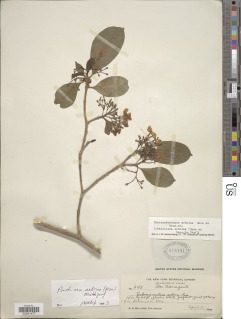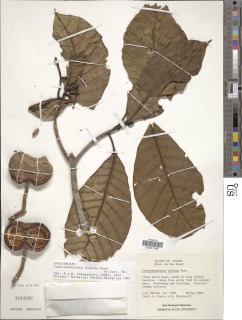

|
|
|
|
Family: Apocynaceae
huevo de gato, more...Huevos de gato
[Peschiera arborea (Rose) Markgr.] |
Description: A moderately-sized forest tree, reaching the canopy but not more than about 70 cm in trunk diameter. The trunk is straight, light-colored with greenish spots, and fluted, slightly flared at the base, usually unbranched for most of its length. Leaves are opposite, shiny, fairly thick to the feel, and drip copious white latex when broken (as does the bark). One of each pair of leaves is nearly always notably larger than the other. Reproduction: Flowers are 2-3 cm across, white, with 5 petals in a pinwheel form (typical of the Apocynaceae), often seen on the ground below trees during the flowering season from March to June. Fruits are in pairs, fairly large (each just larger than a golf ball), light brown in color, often found unbroken on the forest floor at Barro Colorado. Inside is a sweet orange pulp that covers the seeds. Fruits are produced for most of the year. Distribution: Only in forest on the wetter half of the Canal area, from Barro Colorado and Pipeline Rd. north, including the wet forests of Santa Rita. Numerous and easy to spot at Barro Colorado. Similar Species: Easiest to recognize as an adult on Barro Colorado, where there are many trees of nearly the same trunk size. The very light coloring and fluted effect is notable and distinctive. Juveniles are common in the forest, and opposite leaves which drip white latex when broken, unequal in size. One other Apocynaceae, are LK stemgr Stemmadenia grandiflora, LK2 also has opposite, unequal leaves with lots of white latex. It's a small tree, with yellow flowers, but in the absence of flowers, the two can be confused. Other Apocynaceae (LK lacmpa Lacmellea panamensis, LK2 LK malogu Malouetia guatemalensis) LK2 have opposite leaves with white latex, but the two leaves in a pair are equal in size. Uses: This species sprouts easily when cut, and is occasionally used in living fences. Descripción: Árbol de 10 a 25 m de alto. Tronco ligeramente acanalado y con raíces tablares pequeñas y bifurcadas en la base. Corteza exterior crema o amarillenta y con manchas verdes o gris. Ramitas terminales con lenticelas blancas. El desprendimiento de cualquier parte de la planta produce el flujo de una savia lechosa. Hojas simples y opuestas, de 4-16 x 3-6 cm, ovadas o elípticas, con ápice acuminado, bordes enteros a ondulados y base aguda. Usualmente en cada par de hojas una es de mayor tamaño en comparación con la otra. Pecíolo de 0.6-1.5 cm de largo y ligeramente acanalado en la parte superior. Flores blancas y aromáticas, con la parte central de color amarillo. Frutos en folículos pares, de 5-7 cm de largo y en forma de un ‘rinón’, cubiertos de lenticelas blancas en la superficie exterior y dehiscentes al madurar. Semillas envueltas en una pulpa roja o anaranjada. Datos Ecológicos: La especie crece a bajas y medianas elevaciones, en bosques húmedos o muy húmedos. En Panamá se encuentra en las provincias Bocas del Toro, Colón, Darién, Veraguas y la comarca de Guna Yala. Común y fácil de observar en el bosque viejo de la isla de Barro Colorado. Florece y fructifica de marzo a octubre. Especies Parecidas: A menudo se confunde con LK stemgr Stemmadenia grandiflora LK2 , pero S. grandiflora tiene flores amarillas y los frutos terminan en una punta aguda. LK tab2pe Tabernaemontana longipes LK2 también tiene hojas muy parecidas, pero en T. longipes las flores no presentan la parte central de color amarillo, como ocurre en T. arborea. Usos: La madera se utiliza para postes en cercas vivas debido a que rebrota con facilidad. Wild orange Tree, to 20 m tall and 55 cm dbh, weakly buttressed, sometimes involuted, usually glabrous; bark with small vertical rows of lenticels; wood hard, heavy; sap milky, copious. Leaves opposite; petioles 2-11 mm long, with a prominent interpetiolar ridge (leaving a prominent scar), glandular in axils; blades mostly elliptic to obovate, short-acuminate, obtuse to acute at base, 5-18 cm long, 2.5-6 cm wide, dotted with brown glands below. Corymbs terminal; pedicels to 1 em long; bracteoles 1.5-2 mm long; flowers fragrant, many, 5-parted; calyx lobes ovate, 1.5-3 mm long, each with several slender squamellae inside at base; corolla white, the limb ca 2 cm wide, the tube to 9 mm long, swollen in basal half, pubescent inside above the point of staminal attachment; stamens included, attached just above base of tube; anthers ca 3.2 mm long, free; style and stigma 1, 5-lobed, ca 2 mm long; nectaries lacking. Follicles 2, reniform, to 7.3 cm long and 5 cm wide; exocarp roughened, splitting at maturity to expose orange matrix and brown seeds; seeds oblong, many, to 13 mm long, longitudinally striate. Croat 5242, 5419. Common in and mostly restricted to the older forest. Flowers mainly from March to June. Flowering time and intensity may vary from year to year. R. Foster (pers. comm.) reports that in one year trees flowered synchronously and heavily over a few weeks, but that in the next year there was intermittent flowering over several months. Time of fruit maturity is uncertain, possibly during the dry season (January to March). The fruits are eaten by white-faced monkeys in June (J. Oppenheimer, pers. comm.). |
|
|
|

